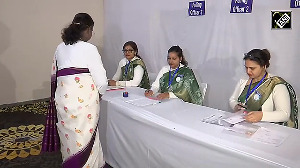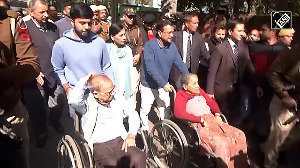Arindam Banerji's strategic plan to make corporate India and the Indian nation forces to reckon with globally. The second of a three-part series.
A
t the cost of repeating myself, I'll focus on a few specific issues and stay out of the juicier battles over political ideologies:India's poor image abroad
Much of the focus on India in the US and the UK these days is related to outsourcing of white-collar jobs.
The fever pitch borders on racism, even in well-respected editorials, publications and Web sites.
The comparison is always between the $40/hour wizard from Kentucky and the $2/hour coolie from Bangalore or something quite as ridiculous.
Nonsensical, unrelated issues get mixed into this, many of which are pure hatemongering. Now some of this is to be expected and did happen to the Japanese too in the eighties. But, most of this is due to sheer ignorance.
How many people know about the GE's research arm in India, about Intel's IP creation in India, Dr Trehan's heart operations, or even Andhra Pradesh State Transport's radical new use of telematics?
There are many examples, but when we get the foreign media in India, we usually get busy convincing them about our woes with Pakistan, glorious tales of our past and, recently, even about our internal differences/divisions.
Sounds almost like snitching to the teacher! Problem is that we're for the most part not telling the true story of India.
Yes, once in a while we have the CBS show on IIT (Indian Institute of Technology), but more often than not, it'll be the ox-cart story in Bangalore or some nitwit pontificating about Kashmir.
Where's the true story? Who is talking about Indian creativity, democracy and growing educated masses? No, I'm not looking for Manjeet Kriplani to do a puff piece on Indian industry, but rather Nick Kristof (of the New York Times) talking delightedly about the emerging capital of the world. But how?
India's poor image in India
Simply put, we do not tell our children about the good in India, nor do we tell them that they can be the best scientists, engineers, doctors or leaders in the world.
We do not build into them arrogance required to believe in their ability to change the world.
During my years of education at some of the most respected institutions in India, I always noticed that students who asked hard, out-of-the-norm questions were never encouraged. Thinking against the grain was never recommended or suggested, let alone taught.
Neither were we told about Indian achievements. Who knew about Indian help to the millions of refugees in 1971, who knew about Bose Systems, who knew about the invention of radio? Most of us learned all this outside the school.
Sure, talking about some of this, takes on political overtones. But, political overtones be damned, there is nothing wrong in inculcating independent thinking, a sense of pride and enough intellectual arrogance to create better ideas.
The results of not doing so are there for all to see: groups of intelligent people afraid to create new ideas. Just the other day, I was speaking to a person who's been in the Indian technology industry for over two decades, but he was not confident that Indian companies could create new software products on their own.
Seems, we need a phirang to come in and tell us how to do it.
Just as an example, most Indians still have a miserable opinion of the LCA (Light Combat Aircraft) program of Hindustan Aeronautics Ltd, whereas in reality the project has actually worked wonders, given the lack of funds and constraints on acquiring technology from the West.
Most Indians have hardly any idea about the kind of work that is being done at GE Research or in IIT-Kanpur.
But, why is this the case? Why not tell our children about our successes? Why can't the same people who make waves at Bell Labs or IBM turn things upside down at Defence Research and Development Organisation?
The issue of lack of better facilities as a sole excuse does not wash since I've seen the difference in algorithms research, which does not need any infrastructure.
True, some of this is changing slowly -- we now do have leaders like Narayana Murthy and the Ambanis; but for the most part the norm is strictly followed -- no creative arrogance. Not surprisingly, Michael Porter of Harvard ranks India 38th amongst all nations, in our innovation capacity, well after countries like Lithuania, Chile, Estonia and Slovenia; only one rank above Costa Rica. Not a good situation.
Poor Human Infrastructure Development
Coined a new term, since all old ones have weird connotations. To me, Krish not being able to teach graduate students at IISc, is poor human infrastructure development. Other examples exist too. (Infosys chairman) N R Narayana Murthy always complains about the lack of managerial skills in the Indian government -- its not that we do not have capable people, we just have not handed them the reins. I know about an MNC printer assembly plant plan being moved to China after a three-year wait; all for a new road to be constructed. You may call it corruption or incompetence. I call it poor human infrastructure development. Wrong people for the wrong job.
The Delhi Metro development and the relatively rapid development of the golden quadrilateral of highways are both a result of having focused, competent and capable people at the right positions. This is exactly what we need much more of.
Getting the right people in the right positions is probably the hardest thing to do, but it is also perhaps the most important thing to do.
As most of us have seen, companies where ability and demonstrated results are the barometers of success, tend to do much better than companies where seniority and nepotism work wonders.
Changing this may be hard, but it is something that has to be taken on. If this problem is not fixed, fixing the others will not make much of a difference.
Now that some of the problems have been outlines, where do we start fixing things?
Where do we want to be by 2015?
Before anything can be fixed, we need to agree on what 'fixed' looks like -- meaning, what is success in this venture going to be defined as?
India, being a poor country, should set metrics on poverty-alleviation, education for women and ensuring that no child goes hungry. But, what would we consider a successful business/industrial image?
It does not take a rocket scientist to figure out what India's greatest strength is -- I'm talking about the kind of strength that can be used to win in the globalised economy. For sure, its not natural resources like oil -- compared to large countries our size, we are not quite as rich in natural resources.
Quite frankly, in the next ten years we're not going to become the dominant manufacturing power in the world either -- we may do well, but no, we're not on our way to becoming the dominant power here.
What we have to sell to the world, is the creative, entrepreneurial and innovative spirit of our people. Believe me, there were other cheap sources of labour available for IT -- but, India won out, because of the education levels, the numbers and our single-minded focus on quality.
For example, as far as I know, Wipro today is the only company in the world that has both PCMM-5 and CMM-5 certifications.
Imagine, no other IT company in the world has achieved this capability. Even when speed of delivery and not money was the business constraint in the late-nineties, many of us chose to aggressively outsource to India over the United Kingdom, Singapore or Germany.
So, in some sense, Indians are already showing the way. India is, with some degree of trepidation, moving towards becoming an intellectual centre for many different fields. But, can India project itself as the future intellectual capital of the world?
The primary design and research centres for microchips, software products, automobile subsystems and pharmaceuticals; known centre for various medical research and procedures, aerospace manufacturing and with some hope microchip fabrication.
Yes, some of the innovation in these areas is happening in India, but we have a long, long way to go and a lot of competition to overcome, before India becomes the true innovation hub for these areas.
But, to get there, we must affix the metrics that India Inc. needs to shoot for. Essentially, the question is -- how do we know, we have reached our goals?
It is somewhat difficult to decide on such metrics, but here's a set of five metrics that could act as a starting point:
- Innovation: Innovation Index in top 12 in the world.
- Trade: Trade percentage of total world trade -- 4.5 per cent.
- Education: Three schools each in the top 25 best medical, engineering and management schools in the world; global player in the higher education market.
- Industry: Top five industry sizes in each of the following segments: retail, automobile, aerospace, semi-conductors, IT (software/hardware), biotechnology, processed foods and pharmaceuticals.
- HRD: Literacy for girls 6 through 14 85 per cent; Internet access -- 200 million people; cell-phone access -- 300 million.
So, how do we get there?






 © 2025
© 2025